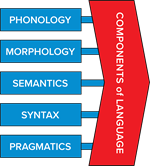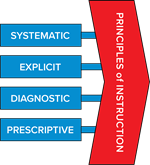Structured Literacy

The structured literacy approach to language, reading, and writing assessment and instruction:
- Acknowledges that the end goal of reading and writing instruction is for students to comprehend and convey meaning through the written word.
- Emphasizes the critical role that language processes and the components of language play in reading and writing development.

- Promotes teaching listening, speaking, reading, and writing skills in an integrated manner using scientific, evidence-based teaching methods that are systematic and explicit.

Because of the solid research base underlying the principles and practices associated with this approach, it has been named in Connecticut’s dyslexia-specific legislation since 2015 and has, in recent years, become incorporated into states’ general education reading reform initiatives, including Connecticut’s K-3 Literacy Strategy.
Paramount among the legislative charges assigned to the ODRD is that which tasks the office with developing, and updating as necessary, Structured Literacy competency targets (knowledge and skill) to be achieved by educators based on their certification level and endorsement type prior to the awarding of a Connecticut teaching credential. This charge is designed to ensure that Connecticut’s educators enter the teaching profession with a shared baseline of literacy knowledge and skill, rooted in current research and best practice, sufficient for them to effectively assess and teach reading and writing according to the expectations of their credential-specific appointments.

The far-reaching impact of the structured literacy competency targets supports the Connecticut State Department of Education’s (CSDE) enhanced commitment to scientific evidence-based literacy instruction. Specifically, for example, the competency targets developed by the ODRD will inform Connecticut’s certification regulations, EPP curricula, the EPP program approval process, certification eligibility protocols, and model in-service training programs. Additionally, all existing and future webinar modules and training developed or endorsed by the CSDE will be aligned with these competencies to enable end users to craft an individualized, competency-focused course of professional growth and development. The structured literacy competency targets also support the sustainability of Connecticut’s Literacy Model, which is dependent on an educator workforce that possesses the requisite knowledge and skill to effectively implement schoolwide reading models that reflect scientifically informed, evidence-based practices.
Learn More
-
Structured Literacy: An Introductory Guide: The International Dyslexia Association
This Educator Training Initiatives Brief provides an overview of the structured literacy approach to teaching reading, provides considerations for how to select a structured literacy method, program, or branded approach; and speaks to the preparation of teachers to deliver instruction from a structured literacy perspective.
- Science of Reading: Defining Guide: The Reading League
This resource proposes a common definition for the term science of reading, summarizes what the science of reading reveals about how reading is processed in the brain, reviews two common theoretical models of reading; and, for each essential component of reading, presents a few instructional practices aligned with the science of reading for consideration.

